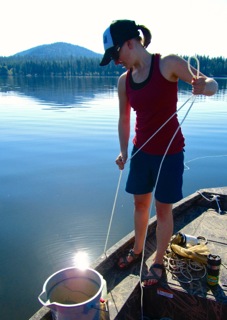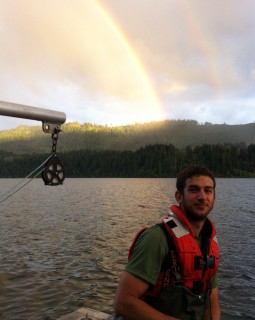The Washington Lakes Protection Association awards two scholarships each year: the Nancy Weller Memorial Scholarship and the David Lamb Memorial Scholarship, both named in honor of long-term influential members of WALPA. Candidates for these competitive scholarships must be students currently enrolled at a college or university proposing to undertake research on the biology, ecology, hydrology, and management or restoration of lakes and watersheds in Washington or Idaho.
Once again this year, there was strong competition for the scholarships, and applicants spanned the spectrum from undergraduate to graduate students with diverse interests. We thank all the students who took the time to apply. Though we could only award two scholarships, we encourage all students to submit an abstract and present their research at the upcoming WALPA conference which will again feature a student session. Please join the scholarship committee and the WALPA Board in congratulating this year’s winners. Read below to learn about our two winners and their research interests.
Megan Skinner
 Understanding fish diet is essential to effectively manage fish populations, especially those facing the dual threats of climate change and cultural eutrophication that may alter lake food web dynamics. If fish prey densities are not sufficient to support existing fish populations, fish survival and growth will ultimately suffer. Additionally, if several fish species are competing for the same prey source, desirable fish species will be negatively affected and management action may be necessary.
Understanding fish diet is essential to effectively manage fish populations, especially those facing the dual threats of climate change and cultural eutrophication that may alter lake food web dynamics. If fish prey densities are not sufficient to support existing fish populations, fish survival and growth will ultimately suffer. Additionally, if several fish species are competing for the same prey source, desirable fish species will be negatively affected and management action may be necessary.
Stable isotope analysis (SIA) is becoming an increasingly powerful tool to examine diet, specifically predator-prey relationships, competition, and food web dynamics. The use of liver in SIA diet and food web studies of slow-growing coldwater organisms (such as trout) needs further methods investigation and development, specifically where tested methods are lacking.
My current research focuses on the use of stable isotope analysis to determine the influence of hypolimnetic oxygenation on fish diet in North Twin and South Twin Lakes on the Colville Confederated Tribes (CCT) Reservation in Washington. For CCT members, Twin Lakes trout are valuable subsistence, economic, and cultural resources; restoring the fisheries in these lakes is of the utmost importance to rural CCT communities.
My long-term goal is to determine how restoration of meso- and eutrophic lakes, using technologies such as hypolimnetic oxygenation, impacts fish diet in temperate lakes. My objective is to determine if lipid extraction in the livers of rainbow trout (Oncorhychus mykiss), brook trout (Salvelinus fontinalis), largemouth bass (Micropterus salmoides) and golden shiner (Notemigonus crysoleucas) significantly affects stable carbon isotope ratios reflecting diet carbon. Additionally, I will determine whether tissue fractionation of stable carbon and nitrogen isotopes is species-specific. Given the utility of stable isotope analysis in clarifying diet and food web dynamics, improved methods are critical for examination of animal diets.
Mark Sorel
 An increasing number of public utilities, hydroelectric, and irrigation interests are considering anadromous salmonid reintroductions as part of their Federal Energy Regulatory Commission (FERC) relicensing. My research evaluates the feasibility of such reintroductions above three hydroelectric dams on the Lewis River in southwest Washington. In my work, I investigate physical limnology, zooplankton, and fish bioenergetics to assess seasonal carrying capacity and predation losses for reintroduced salmonids. Examining key seasonal physical characteristics of the reservoirs such as the thermal regime, summer stratification, and turbidity, in combination with zooplankton abundance and distribution, will help determine the potential for salmonid growth. Furthermore, I use bioenergetics models to quantify the number of salmonids that could be supported by the available zooplankton prey resources. Seasonal diets and consumption demands of the existing resident fish community are being investigated to construct quantitative food webs, and explore potential competitive or predatory interactions between resident fish and reintroduced anadromous salmonids. I hope that this research will help managers identify opportunities for successful salmonid reintroductions, and provide a better understanding of the existing food webs in the Lewis River system. This outcome would help direct restoration efforts to best meet the goals of the stakeholders, maximizing the quantity and quality of habitat for salmonids given available resources.
An increasing number of public utilities, hydroelectric, and irrigation interests are considering anadromous salmonid reintroductions as part of their Federal Energy Regulatory Commission (FERC) relicensing. My research evaluates the feasibility of such reintroductions above three hydroelectric dams on the Lewis River in southwest Washington. In my work, I investigate physical limnology, zooplankton, and fish bioenergetics to assess seasonal carrying capacity and predation losses for reintroduced salmonids. Examining key seasonal physical characteristics of the reservoirs such as the thermal regime, summer stratification, and turbidity, in combination with zooplankton abundance and distribution, will help determine the potential for salmonid growth. Furthermore, I use bioenergetics models to quantify the number of salmonids that could be supported by the available zooplankton prey resources. Seasonal diets and consumption demands of the existing resident fish community are being investigated to construct quantitative food webs, and explore potential competitive or predatory interactions between resident fish and reintroduced anadromous salmonids. I hope that this research will help managers identify opportunities for successful salmonid reintroductions, and provide a better understanding of the existing food webs in the Lewis River system. This outcome would help direct restoration efforts to best meet the goals of the stakeholders, maximizing the quantity and quality of habitat for salmonids given available resources.









